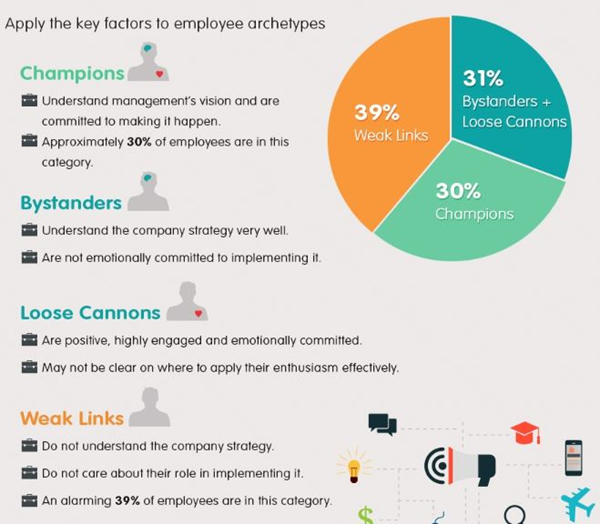Are Loose Cannons Driving Down Your Employee Engagement Scores?
How to channel over-enthusiasm into something productive.
Have you ever worked with a “loose cannon”? This high-energy person moves ahead too quickly without checking facts. Loose cannons mean well, but their unpredictability causes collateral damage. Typically, loose cannon employees are seen as a liability—and management is often looking for ways to help them “find new employment opportunities.” Frankly, I’ve not had a lot of patience with loose cannons in the past; I appreciate people with self-control. Recently I discovered a turn of phrase that prompted me to reconsider my viewpoint on loose cannons.
The folks at Newsweaver sent me this infographic about employee engagement. About midway through the infographic they highlight four employee archetypes and how each archetype contributes to employee engagement. As you can see from the infographic excerpt below, Newsweaver’s research indicates that employees can be engaged not at all (no surprise there), intellectually (as indicated by the shaded blue brain) and/or emotionally (the red heart).
The loose cannon archetype is an employee who is emotionally connected to the organization’s vision, as evidenced by their high energy and passionate commitment. What this type of employee lacks, according to Newsweaver, is the clarity on “where to apply their enthusiasm effectively.” Interesting.
This slight shift in perspective made me wonder: What if the loose cannons in your organization could become champions? Is it possible to channel the over-enthusiasm into something more productive? If it really is a matter of helping them understand how to better redirect their enthusiasm, then that seems a worthwhile use of a leader’s time. Hiring new employees is time-consuming and expensive, so helping an employee on the brink of termination benefits everyone.
Here are four ways leaders can channel misdirected employee enthusiasm:
- During one-to-one time, ask the employee what her or her understanding of the organization (or department) vision is. You may uncover misperceptions that you can then clarify.
- Give the employee feedback when he or she oversteps. You will need to walk the thin line of praise (“I admire your enthusiasm”) and correction (“When you invited the whole team without checking with the manager, it caused a budget crunch. Let’s walk through how you can handle that differently next time.”)
- Coach the employee to develop several colleagues as “sounding boards.” Suggest even-tempered co-workers to the loose cannon—people who will help them think through their actions before they launch into a large project or a risky undertaking.
- Help the employee see examples of positive role models. Think of a few champions that display the appropriate level of intellectual and emotional commitment. Create opportunities for your loose cannon to observe the champion in action. Better yet, find a way for the two people interact. For example, broker a lunch meeting, or find a way that they can work on a small project together.
There are some loose cannons that are simply too volatile to be productive players in your organization. However, if over-enthusiasm is the primary cause of an employee’s missteps, then leaders have recourse. Through coaching, praise, and redirection leaders can up the percentage of champions in their organization and create an even stronger sense of employee engagement.
To read more about Newsweaver’s research, download a copy of their whitepaper “Driving Employee Engagement through Internal Communications.”
Jennifer Miller is a writer and leadership development consultant. This article originally appeared on her blog The People Equation.
(Image via dslaven/Shutterstock.com)








